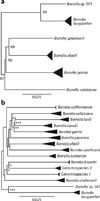Genetics of Borrelia burgdorferi
- PMID: 22974303
- PMCID: PMC3856702
- DOI: 10.1146/annurev-genet-011112-112140
Genetics of Borrelia burgdorferi
Abstract
The spirochetes in the Borrelia burgdorferi sensu lato genospecies group cycle in nature between tick vectors and vertebrate hosts. The current assemblage of B. burgdorferi sensu lato, of which three species cause Lyme disease in humans, originated from a rapid species radiation that occurred near the origin of the clade. All of these species share a unique genome structure that is highly segmented and predominantly composed of linear replicons. One of the circular plasmids is a prophage that exists as several isoforms in each cell and can be transduced to other cells, likely contributing to an otherwise relatively anemic level of horizontal gene transfer, which nevertheless appears to be adequate to permit strong natural selection and adaptation in populations of B. burgdorferi. Although the molecular genetic toolbox is meager, several antibiotic-resistant mutants have been isolated, and the resistance alleles, as well as some exogenous genes, have been fashioned into markers to dissect gene function. Genetic studies have probed the role of the outer membrane lipoprotein OspC, which is maintained in nature by multiple niche polymorphisms and negative frequency-dependent selection. One of the most intriguing genetic systems in B. burgdorferi is vls recombination, which generates antigenic variation during infection of mammalian hosts.
Figures





References
LITERATURE CITED
-
- Alghaferi MY, Anderson JM, Park J, Auwaerter PG, Aucott JN, et al. Borrelia burgdorferi ospC heterogeneity among human and murine isolates from a defined region of northern Maryland and southern Pennsylvania: lack of correlation with invasive and noninvasive genotypes. J. Clin. Microbiol. 2005;43:1879–1884. - PMC - PubMed
-
- Alitalo A, Meri T, Lankinen H, Seppälä I, Lahdenne P, et al. Complement inhibitor factor H binding to Lyme disease spirochetes is mediated by inducible expression of multiple plasmid-encoded outer surface protein E paralogs. J. Immunol. 2002;169:3847–3853. - PubMed
-
- Alverson J, Bundle SF, Sohaskey CD, Lybecker MC, Samuels DS. Transcriptional regulation of the ospAB and ospC promoters from Borrelia burgdorferi. Mol. Microbiol. 2003;48:1665–1677. - PubMed
-
- Andam CP, Fournier GP, Gogarten JP. Multilevel populations and the evolution of antibiotic resistance through horizontal gene transfer. FEMS Microbiol. Rev. 2011;35:756–767. - PubMed
RELATED RESOURCES
-
- Hunfeld K-P, Brade V. Antimicrobial susceptibility of Borrelia burgdorferi sensu lato: what we know, what we don’t know, and what we need to know. Wien. Klin. Wochenschr. 2006;118:659–668. - PubMed
-
- Radolf JD, Caimano MJ. The long strange trip of Borrelia burgdorferi outer-surface protein C. Mol. Microbiol. 2008;69:1–4. - PubMed
-
- Samuels DS. Antibiotic resistance in Borrelia burgdorferi: applications for genetic manipulation and implications for evolution. In: Cabello FC, Hulinska D, Godfrey HP, editors. Molecular Biology of Spirochetes. Amsterdam, The Netherlands: IOS Press; 2006. pp. 56–70.
Publication types
MeSH terms
Substances
Grants and funding
LinkOut - more resources
Full Text Sources

